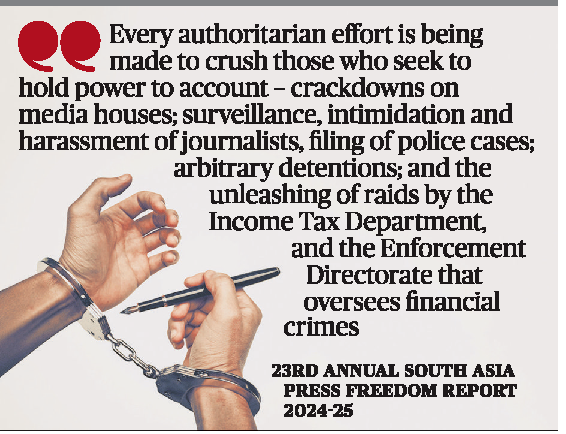Thalassemia Burden in West Bengal higher than National Average

- 12 May 2025
In News:
On World Thalassemia Day, health experts in West Bengal highlighted the state’s significantly higher prevalence of Thalassemia carriers, ranging from 6% to 10%, compared to the national average of 3% to 4% (2011 Census). The elevated rate is mainly attributed to low awareness, intra-community marriages, and inadequate genetic screening.
What is Thalassemia?
- Definition: Thalassemia is a hereditary blood disorder marked by the body’s inability to produce adequate or normal haemoglobin, impairing oxygen transport in the blood.
- Genetic Cause:It arises from mutations or deletions in genes responsible for haemoglobin chains (alpha or beta globin), inherited from both parents.
- Types:
- Alpha Thalassemia: Involves up to four gene deletions; severity varies with number of deletions; common in Southeast Asian, Middle Eastern, and African populations.
- Beta Thalassemia: Caused by mutations in the beta-globin gene; prevalent in Mediterranean, South Asian, and Chinese communities. Includes:
- Thalassemia Minor: Carrier state with mild or no symptoms.
- Thalassemia Major (Cooley’s Anaemia): Severe form requiring lifelong blood transfusions.
- Symptoms:Fatigue, weakness, jaundice, facial deformities, stunted growth, enlarged spleen and liver, and breathlessness.
Thalassemia in India and West Bengal
- India sees about 10,000 to 15,000 babies born annually with Thalassemia Major (National Health Mission, 2016).
- Certain communities like Bengalis, Sindhis, Punjabis, and Gujaratis have higher carrier frequencies.
- West Bengal reports over 18,000 transfusion-dependent Thalassemia patients with a patient positivity rate of 2.5%.
Challenges in West Bengal
- Low Awareness: Many remain uninformed about genetic transmission and implications.
- Intra-community Marriages: Increase risk of two carriers marrying, leading to affected children.
- Insufficient Screening: Inadequate prenatal and adolescent screening limits early detection and prevention.
- No Legal Framework: India lacks laws to prevent marriages between carriers; awareness is the key preventive strategy.
Government Efforts and Recommendations
- West Bengal has established 36 Thalassemia Control Units (TCUs) across districts focusing on screening pregnant women (especially in the first trimester) and adolescents to reduce future disease incidence.
- Experts emphasize early parental screening, informed counseling, and timely medical care.
- Supportive care includes regular blood transfusions, iron chelation therapy, vaccinations, nutritional balance (low iron diet), infection prevention, and mental health counseling.
Expanded Credit Guarantee Scheme for Startups (CGSS)

- 12 May 2025
In News:
In a significant push to support innovation, domestic manufacturing, and startup growth, the Government of India has doubled the credit guarantee limit under the Credit Guarantee Scheme for Startups (CGSS) from ?10 crore to ?20 crore per borrower. Additionally, it has enhanced the guarantee coverage and reduced the guarantee fees for selected high-priority sectors.
About CGSS (Credit Guarantee Scheme for Startups)
- Launched: October 2022
- Under: Startup India Action Plan (initiated January 16, 2016)
- Nodal Ministry: Department for Promotion of Industry and Internal Trade (DPIIT), Ministry of Commerce and Industry
- Implemented by: National Credit Guarantee Trustee Company (NCGTC)
- Objective
- To enable collateral-free debt funding to DPIIT-recognised startups via:
-
- Term loans
- Working capital
- Venture debt and other fund-based/non-fund-based credit instruments
- To reduce the perceived credit risk for financial institutions and promote early-stage innovation, R&D, and self-reliant manufacturing.
Key Features of the Expanded CGSS
Parameter Previous Provision Revised Provision
Credit Guarantee Limit ?10 crore ?20 crore per borrower
Guarantee Coverage 75% 85% for loans ≤ ?10 crore, 75% for loans >
?10 crore
Annual Guarantee Fee (AGF) 2% 1% for startups in 27 Champion Sectors
Eligible Instruments Fund-based & non-fund based Includes venture debt, debentures,
subordinated debt
Guarantee Issuance Manual process Automated via NCGTC portal
Umbrella Guarantee Not earlier specified Covers pooled investments
(up to ?20 crore or 5% loss)
Eligible Startups & Lenders
Startups must be:
- Recognised by DPIIT
- Not classified as Non-Performing Assets (NPA)
- Certified eligible by the lending institution
Lending Institutions include:
- Scheduled Commercial Banks
- NBFCs (rated BBB+ and above, net worth ≥ ?100 crore)
- SEBI-registered Alternative Investment Funds (AIFs)
Focus on Champion Sectors
To strengthen the Make in India initiative, the reduced AGF of 1% applies to 27 Champion Sectors, which include:
- 15 Manufacturing Sectors:Aerospace &defence, automotive components, biotechnology, chemicals, petrochemicals, electronics, pharmaceuticals, etc.
- 12 Services Sectors:IT &ITeS, tourism, hospitality, medical value travel, accounting and finance, audio-visual services, among others.
Expected Outcomes
- Improved Credit Access: More financial institutions are expected to extend funding to startups due to increased guarantee coverage and reduced risk.
- Encouragement for Innovation: Easier credit access will facilitate R&D, product development, and new-age technological innovation.
- Boost to Self-Reliance: Priority manufacturing and service sectors will benefit from reduced funding costs, promoting Atmanirbhar Bharat.
- Alignment with Viksit Bharat Vision: Supports long-term goals of inclusive economic growth through entrepreneurship and job creation.
Discovery of Chirality in KV?Sb?
- 12 May 2025
In News:
In a major advancement in condensed matter physics, researchers have identified a chiral quantum state in KV?Sb?, a topological material with a Kagome lattice structure. This discovery is significant as the material was earlier thought to be non-chiral, making this the first observation of intrinsic chirality in a bulk topological quantum system.
What is Chirality?
- Chirality refers to the geometric property of an object not being superimposable on its mirror image—a concept known as "handedness".
- It is common in nature, observed in:
- Amino acids
- The double helical structure of DNA
- Spiral patterns in biological systems
- Molecules often exist in left-handed (L) and right-handed (D) forms, a feature crucial to both biochemistry and quantum physics.
About KV?Sb? and the Kagome Lattice
- KV?Sb? is a bulk quantum material characterized by a Kagome lattice—a structure formed by corner-sharing triangles.
- The Kagome pattern, originating from Japanese basket-weaving, serves as a fertile platform for investigating topological and quantum phenomena like superconductivity, charge ordering, and now, chirality.
Scientific Technique Used
- Researchers employed a novel tool called the Scanning Photocurrent Microscope (SPCM).
- Unlike Scanning Tunnelling Microscopy (STM), which offers atomic-resolution images, SPCM is designed to detect nonlinear electromagnetic responses in materials.
- The SPCM detected handedness in the photocurrent, confirming the circular photogalvanic effect (CPGE)—a definitive marker of chirality.
Key Findings
- The material exhibited spontaneous symmetry breaking, particularly the formation of a charge density wave (CDW).
- At 4 Kelvin, KV?Sb? responded differently to right- and left-handed circularly polarized light, demonstrating the breaking of mirror and inversion symmetries.
- This confirms the presence of intrinsic chiral charge order, marking the first such observation in a bulk topological material.
23rd South Asia Press Freedom Report (2024–25)

- 12 May 2025
In News:
The 23rd Annual South Asia Press Freedom Report 2024–25, titled “Frontline Democracy: Media and Political Churn”, flags a concerning decline in media freedom across South Asia, including India. Published by the Asia Press Freedom group, the report assesses press conditions in eight countries: India, Pakistan, Afghanistan, Sri Lanka, Bangladesh, Nepal, Bhutan, and the Maldives.
Key Findings
- Over 250 violations of media rights recorded.
- 69 journalists were jailed or detained; 20 killed in the line of duty.
- India ranked 151st globally in press freedom; Bhutan dropped to 152nd—its lowest ever.
- Pakistan witnessed its most violent year for journalists in two decades, with eight killed.
India-Specific Observations
Legal and Institutional Suppression
- Increasing use of stringent laws like UAPA, PMLA, defamation, and sedition against journalists.
- Media organizations critical of the government have faced IT raids, ED investigations, and denial of government advertising.
- These actions have led to widespread self-censorship and a chilling effect on critical reporting.
Disinformation and Political Interference
- Political IT Cells play a key role in spreading fake news and hate speech, deepening the trust deficit in mainstream media.
- The Global Risks Report 2024 identifies “manipulated information” as the world’s most serious short-term threat.
Digital & Economic Challenges
- AI-generated content undermines journalistic credibility and originality.
- Media workforce faces challenges from:
- Declining advertisement revenue
- Contractualisation under new labour codes
- Mergers and corporate restructuring
- Precarity of gig and freelance journalists
Gender Inequality
- Poor representation of women in newsroom leadership roles.
- Pervasive gender-based harassment remains unaddressed.
Impacts of Eroding Media Freedom
- Democratic Deficit: Weakens the role of the press as the fourth pillar of democracy.
- Public Mistrust: Rising perception of media bias and loss of credibility.
- Reduced Information Access: Laws like the DPDP Act 2023 and changes to RTI provisions hinder public transparency.
Balochistan
- 12 May 2025
In News:
On May 9, 2025, Mir Yar Baloch announced the unilateral declaration of independence for Balochistan from Pakistan. In a public appeal, he urged India to formally recognize Balochistan as a sovereign state and open an embassy in New Delhi. He also called upon the United Nations to deploy peacekeeping forces and demanded the withdrawal of the Pakistani military from the region.
Geographical Profile
- Location: Balochistan lies in the southwestern part of Pakistan and is the country’s largest province by area, comprising nearly 44% of its total territory.
- Area: Approximately 347,190 square kilometers
- Capital: Quetta, situated near the Afghanistan border
- Borders:
- East: Sindh and Punjab provinces
- West: Iran
- Northwest: Afghanistan (across the Durand Line)
- South: Arabian Sea, with a coastline of around 770 km
Topography and Climate
- Characterized by rugged, mountainous terrain (notably the Sulaiman and Makran ranges)
- Arid and semi-arid climate zones, including desert and dry steppe regions
- Low population density, yet abundant in untapped mineral wealth
Demographics and Ethnicity
- Major Ethnic Group: The Baloch, who trace their ancestry to Iranian origins
- Other Communities: Pashtuns in the northern areas, and the Brahui ethnic group
- Languages Spoken: Balochi, Pashto, Brahui, and Urdu
- Religion: Predominantly followers of Sunni Islam
Strategic and Geopolitical Significance
Natural Resource Wealth
- Balochistan is rich in natural gas, coal, copper, and gold.
- The RekoDiq mining site is among the world’s largest undeveloped gold and copper reserves.
- The province contributes about 40% of Pakistan’s natural gas production, yet remains economically underdeveloped and politically marginalized.
China-Pakistan Economic Corridor (CPEC)
- Gwadar Port, located in southern Balochistan, is a critical node in China’s Belt and Road Initiative (BRI).
- It provides China with direct maritime access to the Arabian Sea and strategic connectivity to West Asia, bypassing the Strait of Malacca.
India’s Strategic Perspective
- India has consistently highlighted human rights violations in Balochistan at international forums.
- The region’s geostrategic position intersects with India’s Indo-Pacific vision, and is relevant in India’s efforts to counter China’s growing footprint through CPEC.
Insurgency and Security Dynamics
- Balochistan has long witnessed separatist movements led by Baloch nationalist groups seeking either enhanced autonomy or full independence from Pakistan.
- These groups frequently target Pakistani military convoys, CPEC infrastructure projects, and Chinese nationals working in the region, signaling strong opposition to external control and resource exploitation.
